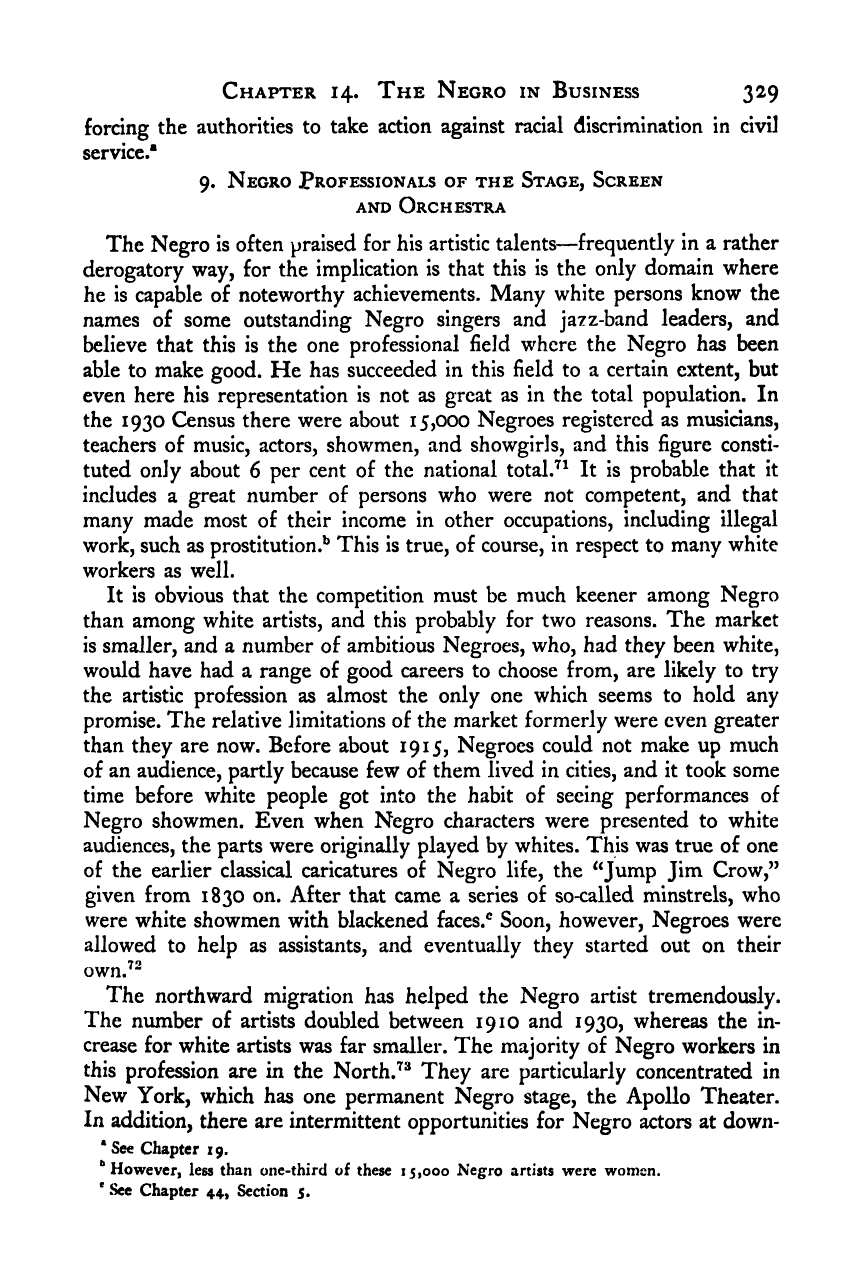Note: Gunnar Myrdal died in 1987, less than 70 years ago. Therefore, this work is protected by copyright, restricting your legal rights to reproduce it. However, you are welcome to view it on screen, as you do now. Read more about copyright.
Full resolution (TIFF) - On this page / på denna sida - IV. Economics - 14. The Negro in Business, the Professions, Public Service and Other White Collar Occupations - 8. Negro Officials and White Collar Workers in Public Service - 9. Negro Professionals of the Stage, Screen and Orchestra

<< prev. page << föreg. sida << >> nästa sida >> next page >>
Below is the raw OCR text
from the above scanned image.
Do you see an error? Proofread the page now!
Här nedan syns maskintolkade texten från faksimilbilden ovan.
Ser du något fel? Korrekturläs sidan nu!
This page has never been proofread. / Denna sida har aldrig korrekturlästs.
Chapter 14. The Negro in Business 329
forcing the authorities to take action against racial discrimination in civil
service.*
9. Negro Professionals of the Stage, Screen
AND Orchestra
The Negro is often praised for his artistic talents—frequently in a rather
derogatory way, for the implication is that this is the only domain where
he is capable of noteworthy achievements. Many white persons know the
names of some outstanding Negro singers and jazz-band leaders, and
believe that this is the one professional field where the Negro has been
able to make good. He has succeeded in this field to a certain extent, but
even here his representation is not as great as in the total population. In
the 1930 Census there were about 15,000 Negroes registered as musicians,
teachers of music, actors, showmen, and showgirls, and this figure consti-
tuted only about 6 per cent of the national total.’^^ It is probable that it
includes a great number of persons who were not competent, and that
many made most of their income in other occupations, including illegal
work, such as prostitution.** This is true, of course, in respect to many white
workers as well.
It is obvious that the competition must be much keener among Negro
than among white artists, and this probably for two reasons. The market
is smaller, and a number of ambitious Negroes, who, had they been white,
would have had a range of good careers to choose from, are likely to try
the artistic profession as almost the only one which seems to hold any
promise. The relative limitations of the market formerly were even greater
than they are now. Before about 1915, Negroes could not make up much
of an audience, partly because few of them lived in cities, and it took some
time before white people got into the habit of seeing performances of
Negro showmen. Even when Negro characters were presented to white
audiences, the parts were originally played by whites. This was true of one
of the earlier classical caricatures of Negro life, the ^‘Jump Jim Crow,”
given from 1830 on. After that came a series of so-called minstrels, who
were white showmen with blackened faces.® Soon, however, Negroes were
allowed to help as assistants, and eventually they started out on their
own.^“
The northward migration has helped the Negro artist tremendously.
The number of artists doubled between 1910 and 1930, whereas the in-
crease for white artists was far smaller. The majority of Negro workers in
this profession are in the North.^^ They are particularly concentrated in
New York, which has one permanent Negro stage, the Apollo Theater.
In addition, there are intermittent opportunities for Negro actors at down-
* See Chapter 19.
“However, less than one-third of these 15,000 Negro artists were women.
’
See Chapter 44., Section 5.
<< prev. page << föreg. sida << >> nästa sida >> next page >>